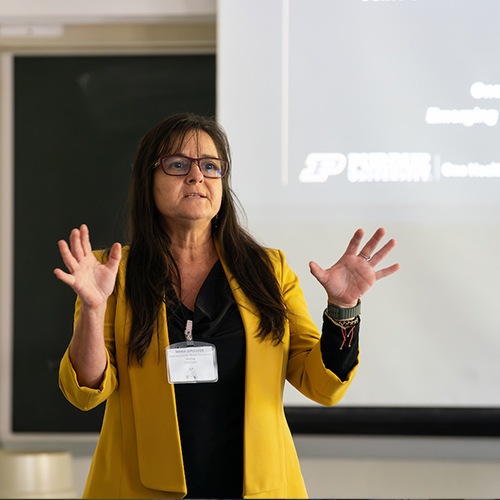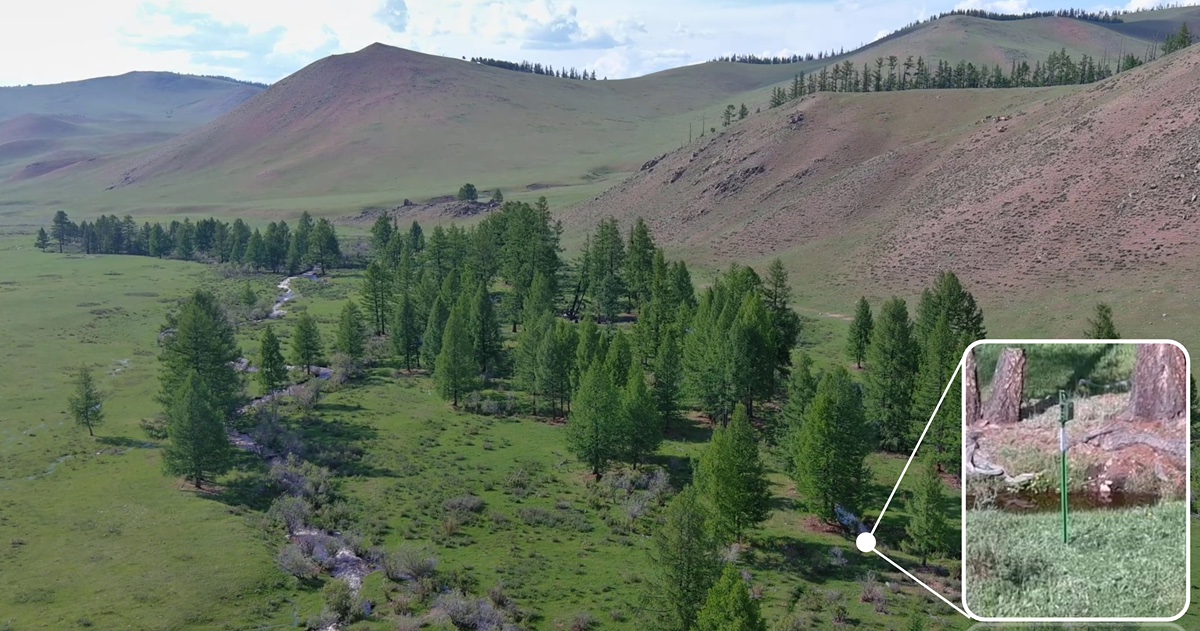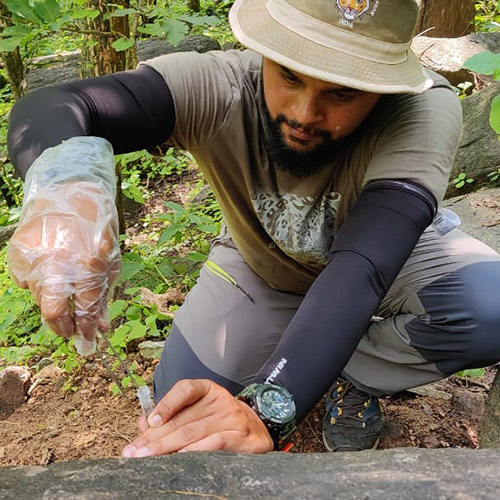Dr. Zackary Delisle Receives 2024 Chase S. Osborn Early Career Award for Wildlife Conservation
The Chase S. Osborn Early Career Award, established in 2021, is presented by Purdue FNR to an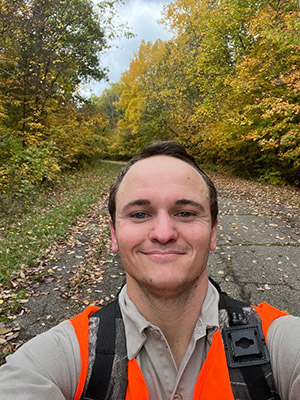 individual who, by writing, research, teaching or other personal accomplishments has made significant contributions to wildlife conservation in the state of Indiana. Dr. Zackary Delisle (PhD 2023), whose research in Indiana was instrumental for enacting deer reduction zones and estimating deer population size for informing annual harvest limits, is the 2024 recipient of the award. Delisle’s publications have broader implications for management of ungulates worldwide.
individual who, by writing, research, teaching or other personal accomplishments has made significant contributions to wildlife conservation in the state of Indiana. Dr. Zackary Delisle (PhD 2023), whose research in Indiana was instrumental for enacting deer reduction zones and estimating deer population size for informing annual harvest limits, is the 2024 recipient of the award. Delisle’s publications have broader implications for management of ungulates worldwide.
“After being notified of my selection for this award, I spent some time reading about Chase Osborn and watching videos of past recipients of the Chase S. Osborn Early Career Award,” Delisle said. “What an incredible group of past recipients; many names that I recognize from the references I've used in my own work or my broader science readings. In short, I am very grateful to be given this distinction. It really does mean a lot to me and encourages me to continue to push hard and try to make a difference for our increased understanding of wildlife ecology and management.”
Delisle grew up in Chicopee, Massachusetts, using nature as a safe haven with his brothers. From fishing for smallmouth bass and dace to hiking or catching turtles and frogs, and later hunting, Delisle was always interested in getting outside.
“We grew up in a city and would try to escape that by just going outside and being around each other,”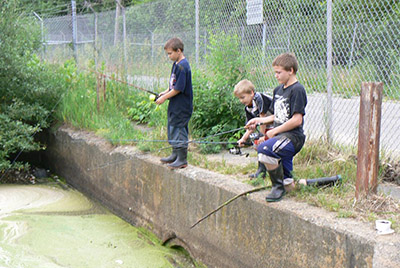 Delisle explained. “We could walk through the city to the local river and there were also some local ponds that we would go to. I have a lot of wonderful memories with my younger brothers Patch and Nick, most of which are outdoors.”
Delisle explained. “We could walk through the city to the local river and there were also some local ponds that we would go to. I have a lot of wonderful memories with my younger brothers Patch and Nick, most of which are outdoors.”
Although he was a high school pole vaulter, Delisle did not initially have plans to attend college, instead he considered being a machinist at a local factory. However, his future brother-in-law Mike, a metal fabricator, asked him to reconsider. Delisle also took inspiration from his grandfathers, J. Kenneth Basin “Papa” and Lewis Pelletier “Pepere,”both of whom were engineers. Zack is very proud of his Papa and Pepere.
After starting college as a criminal justice major, Zack considered the possibility of working as a game warden or conservation officer due to his love for hunting and fishing, so he added an environmental science minor to his coursework.
But an internship left Delisle unfulfilled on the law enforcement front. However, through that internship, he spent some time with the biologists at the Massachusetts Division of Fish and Wildlife, an encounter which ended up being career changing.
“They invited me to go band geese with them, which was a lot of fun,” Delisle said. “I did track in college, so I was somewhat fast and I remember chasing this goose down. That was a blast. After that internship, I knew I didn’t want to be in law enforcement, but that experience with the biologists got me to change my minor in environmental science to a major.”
Delisle jumped feet first into research, doing “as much work as I could handle” on top of being a college athlete and a double major in criminal justice and environmental science.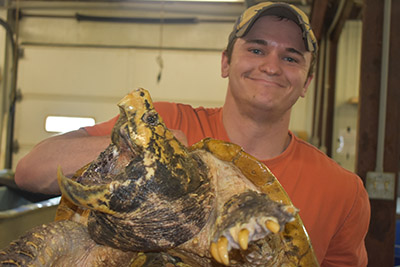
Dr. Tim Parshall, professor of forest biology at Westfield State University, was the first mentor who fed Zack’s research interest.
“He humored me and helped guide me in a couple different projects, some with amphibians and another in dendroecology [study of ecology through the examination of tree rings], looking at the effects of invasive plants on the basal area growth of trees,” Delisle shared. “The tree core work was more of a real project where we were answering specific questions and laying out the project design, collecting the data and processing everything in order to run the statistics. That was really valuable because it taught me a project from start to finish. That was probably the most important unpaid work I did. That’s something I was actually able to publish really early on. Dr. Parshall was good at helping guide my sporadic undergrad brain.”
Combining research, classwork and athletics sometimes meant getting out of track practice in the late evening, putting on waders and driving out to ephemeral wetlands to look for ambystomids and frogs for his senior capstone project, and getting back to campus at 11 p.m. to study, go to bed and wake up to do it all again.
“I definitely tried to do as much as I could,” Zack explained. “Dr. John McDonald had projects where I could work on banding pheasants to look at the effects of public versus private hunting clubs on pheasant harvest, which was cool. He also facilitated small mammal work, estimating deer mice (Peromyscus) abundance, which gave me experience handling wildlife and the responsibility that comes with trapping animals. It taught me that it doesn’t matter what you do the night before, you have to get up at 4:30 a.m. and go check the traps, because you have animals in there waiting.”
Another opportunity through Dr. McDonald allowed Delisle to spend a few weekends with local biologists from the Massachusetts Department of Conservation and Recreation, checking white-tailed deer and giving hunters GPS units so they could record moose locations.
After graduating from Westfield State in 2016, Delisle spent the summer working as a wildlife technician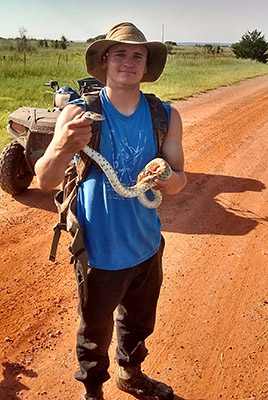 under Dr. Cameron Duquette for the Oklahoma State University Cooperative Fish and Wildlife Unit, performing radiotracking of northern bobwhite quail (Colinus virginianus).
under Dr. Cameron Duquette for the Oklahoma State University Cooperative Fish and Wildlife Unit, performing radiotracking of northern bobwhite quail (Colinus virginianus).
Duquette not only guided Delisle through his research duties but also helped him navigate the details of attaining a graduate position, which he did under Dr. Johanna Delgado-Acevedo at Texas A&M-Commerce.
“With Johanna, my position was cool because it was an open-ended project,” Delisle shared. “Initially the project was working with southern leopard frogs and I thought, well, that is not as interesting as it could be, so I asked her if there was any way I could work with a different species. She said as long as it pertained to wetlands that my project could be flexible. So, I chose to work with cottonmouths (Agkistrodon piscivorus). I have always found venomous pit vipers to be really neat, so I wanted to study them. It was good, fun and hard work. The ecology of many snake species is very nuanced. I have always been fascinated by them. I even have pictures of me when I was pretty young with big water snakes.”
The research involved radiotracking and trapping cottonmouths to assess the home range size, spatial ecology and habitat selection and parturition/neonatal ecology of cottonmouths. Side projects also had Delisle trapping alligator snapping turtles (Macrochelys temminckii) and wetland-inhabiting herpetofauna to look at herp communities and the influence of created wetland size on those communities.
The graduate position also saw Delisle teach laboratory courses for a zoology course.
“I really tried to focus on a lot of applied research and I tried to publish as much as I could because I knew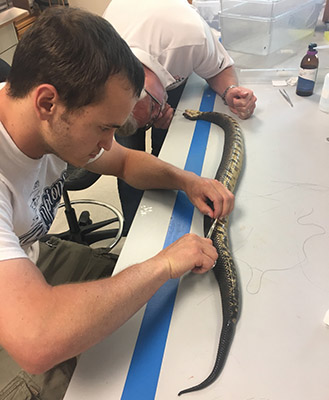 that was important for securing a PhD,” Delisle said. “That is where I really started to enjoy research. I really liked running analytics. I am a huge adrenaline junky. I like to pole vault, I love to go skydiving. But running an analysis gives me some sort of adrenaline too, which sounds super nerdy, but it does. And it makes me happy.”
that was important for securing a PhD,” Delisle said. “That is where I really started to enjoy research. I really liked running analytics. I am a huge adrenaline junky. I like to pole vault, I love to go skydiving. But running an analysis gives me some sort of adrenaline too, which sounds super nerdy, but it does. And it makes me happy.”
Zack wrapped up his master’s at Texas A&M Commerce in 2018, presenting his thesis on “Spatial Ecology and Multi-scale Spatiotemporal Habitat Selection of the Cottonmouth within Constructed Wetland Complexes”
From there, Delisle came to Purdue to work under Dr. Rob Swihart (BS Wildlife 1979; now professor emeritus) on the Integrated Deer Management Project, where his role predominantly focused on population estimation of deer in Indiana.
“Working on population ecology was something new for me,” Delisle shared. “It was quantitatively focused, it was working with Rob, who was a big name in wildlife, and it could give me a lot of unique skills, all while working on a project that had money behind it. All this pointed towards a project that could have widespread impact. Conducting aerial surveys of wildlife and doing camera trapping were new experiences that I also was interested in getting.”
The Integrated Deer Management Project was a collaborative effort which allowed Delisle to work with other PhD students who were studying other aspects of deer management, from plant ecology to human dimensions.
“I got to collaborate with people at the Indiana DNR and other graduate students and I was able to really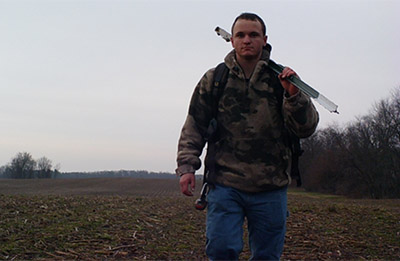 connect the dots between my portion of the project – estimating population sizes – and other parts of the project [social and plants] to see how it related to the other fields of ecology,” he said. “Deer management is very much a multifaceted job. It was helpful that I could gain knowledge and bounce my ideas off other ecologists and collaborate with people, all the way from Indiana to internationally, from Germany and Scotland and Spain.”
connect the dots between my portion of the project – estimating population sizes – and other parts of the project [social and plants] to see how it related to the other fields of ecology,” he said. “Deer management is very much a multifaceted job. It was helpful that I could gain knowledge and bounce my ideas off other ecologists and collaborate with people, all the way from Indiana to internationally, from Germany and Scotland and Spain.”
To date, Zack has authored 20 published papers, several of which pertain to his work on deer. He has published in many top-tier journals for researchers and wildlife professionals including Scientific Reports, Science of the Total Environment, Methods in Ecology and Evolution, Ecosphere, Frontiers in Ecology and Evolution, Forest Ecology and Management, and Wildlife Society Bulletin.
“Zack’s work advanced scientifically based management of white-tailed deer, arguably the most recognizable and economically valuable wildlife species in Indiana,” Swihart, Zack’s PhD advisor, said. “He conducted applied research to inform deer management by improving our understanding of their populations, behavior and ecology. His work was so valuable to the Indiana Department of Natural Resources that they hired him as the DNR Deer Research Biologist immediately upon his graduation, so he could continue his efforts to improve deer management in the state. His research in Indiana has been instrumental in enacting deer reduction zones and determining annual harvest limits. Moreover, his publications have broader implications for management of ungulates worldwide, and peers from six continents have cited his work.”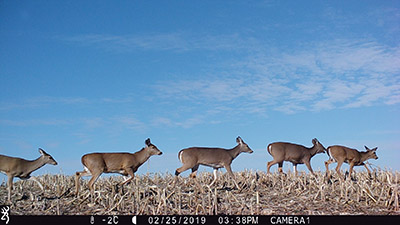
Delisle’s work on deer led to his selection as the early career recipient of the Chase S. Osborn Award for Wildlife Conservation, given yearly to recognize a student, alumni, faculty member or citizen for distinctive contributions to wildlife conservation in Indiana.
“As a kid I went hunting and fishing and hiking, and now I have the ability to do research that potentially influences the experience of other little kids who like to go fishing and hunting,” Delisle shared. “That is really gratifying to me.”
Zack has successfully balanced his research with his family life. In fact, he has his research to thank for meeting his wife, Cate, and he credits his daughter, Jules, for pushing him through the PhD grind.
“I met Cate while I was doing field work in Indiana,” Delisle explained. “She is super cool and I can’t imagine loving anyone more or being with anyone else. She is my rock. When I was done with field work, we decided to start a family, while I was finishing my PhD. My daughter Jules has been a great motivation. She motivates me with her smiles unknowingly. For me, having a child while finishing my grad work made me want to do a better job and work harder.”
After completing his PhD with the dissertation topic “Modeling Density and Group Size of White-Tailed Deer (Odocoileus virginianus) with Distance Sampling,” Delisle seamlessly transitioned into the role of deer research biologist with the Indiana Department of Natural Resources, where he was able to directly apply his Purdue research to management practices.
“I had basically been doing my job at the DNR for the last five years during my PhD,” Delisle said. “Working with the DNR was super cool because it was almost like a postdoc. Joe Caudell saw that I was interested in applied deer research and how I could influence deer management. Joe was super supportive and allowed me to pursue the things I had been interested in throughout my PhD while also continuing to get experience with management, such as harvest limits, deer reduction zones and interacting with the public.”
Delisle was able to study the activity of deer in delineated research units across the state, the findings of which are available in an article titled “Deer activity levels and patterns vary along gradients of food availability and anthropogenic development,” published in Nature’s Scientific Reports. His work examined the relationships between animal activity and the availability and quality of food, proximity to human development and other factors and utilized trail cameras to sample more than 1,000 unique locations during the winters of 2019, 2020 and 2021.
From there, Delisle and Caudell aimed to test the effects of using deer reduction zones to reduce deer-vehicle collisions (DVCs). The results of that work are published in the article “Targeted recreational hunting can reduce animal-vehicle collisions and generate substantial revenue for wildlife management agencies.”
“From 2003 to 2022, there were more than 300,000 reported DVCs in Indiana, with estimated costs to society of more than $2.5 billion dollars,” Delisle shared in the story Research Study Deer-Vehicle Collision Reduction Method. “Therefore, discovering a way to decrease the number of DVCs is important for deer management in Indiana. Knowing that we were able to figure out that increased recreational hunting worked at reducing DVCs feels special because we may have prevented someone from getting seriously hurt or killed. Being able to analyze data on an experiment like this has the potential to really influence how deer are managed in Indiana as well as help people (prevention of costs, human injuries and human fatalities). I am thankful to have been given the opportunity to work on this project with my coauthors. It was really neat to see that working with wildlife could actually save someone’s life.”
The findings of that research have already resulted in the DNR’s efforts to add deer reduction zones to its hunting rules so that their use will continue in the future. DNR deer biologists are also investigating other areas in the state where they believe this management method could be effective.
In February 2024, Delisle along with his wife Cate and daughter Jules made the move to Fairbanks, Alaska, where Zack was hired as an ecologist for the National Park Service. His work for the NPS specifically involves monitoring programs for the Dall’s sheep and brown bear.
“It is a super unique system in that there are a lot of really big mammals interacting with each other,” Delisle explained. “It is a little bit more naturally complex than Indiana is. The scales that you are monitoring at are enormous. Some of the parks are bigger than half of Indiana. My position also allows me to continue to ask landscape level questions, which I did in Indiana, but on an even larger scale now. My supervisor, Eric Wald, is extremely supportive, and gives me the opportunity to further expand the scale of my research with sheep to an international scale and collaborate with biologists in Canada.”
Unlike deer, which are very abundant in Indiana, Dall’s sheep are declining in abundance. The species is important locally due to a tradition of hunting by indigenous peoples.
“It is a very unique challenge,” Delisle stated. “There are a lot of suspected reasons behind sheep population declines. Dall’s sheep are used to very harsh alpine environments. But it appears that extreme winter weather is one of the main causes for much of the population declines in sheep. Sheep need resources to maintain their nutrition and their fat stores and if they don’t have that because of extreme winter weather, that is a big deal in terms of survival.”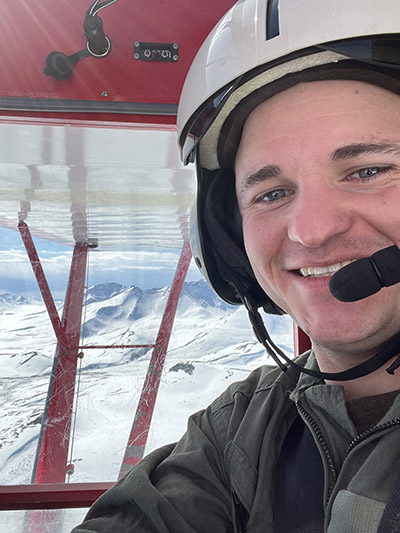
Dall’s sheep monitoring is done by fixed-wing aircraft using visual distance sampling.
Delisle’s work with brown bears involves site/resight work from fixed-wing aircraft as well.
Both projects allow Delisle to use the knowledge and skills he developed throughout his career and his time in graduate school.
“This work involves a lot of the same key concepts and distance sampling that I used with deer, but you have to learn how to apply it to a different system and fulfill some of the same things that need done statistically,” Delisle said. “It keeps my brain working.
“I don’t understand how people could ever be bored working in wildlife. There is always something I could be doing, a question that needs answering. I think curiosity is really important if you want to be in wildlife. It’s good to be curious in research, but just as important for wildlife managers. It is an underlying attribute that can give people a tremendous amount of success. Be curious and pursue your curiosities. No question is too crazy.”




